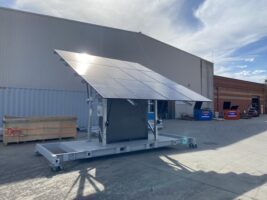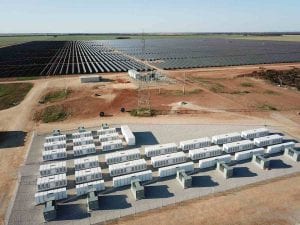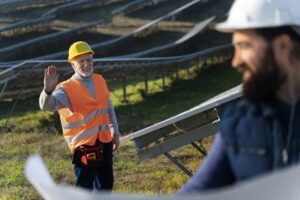The transition from fossil fuels to renewable energy is inevitable. It will happen whether we take action or not. Fossil fuels are – by definition – finite. They are a one-time gift to humanity. Long before they are physically exhausted, we will have turned away from them toward renewable sources of energy simply on the basis of cost.
The question, then, is do we make this transition from fossil fuels to renewable energy on our own terms, in ways that maximize the benefits to us today and to future generations, or do we turn our heads away and suffer the economic and social shocks that rising prices and market volatility will create—as it has done so often in the past.
Of course, by turning toward the sun and the wind and other renewable sources of energy today we alleviate a host of ills that beset us because we burn an ever increasing amount of fossil fuels. By ultimately eliminating fossil fuels, we also eliminate the air pollution and social disruption caused by their mining, refining, and combustion. We also eliminate the emission of global warming gases as well.
Taking action today – on our own terms – enables us to profit by the energy transition in the present as well as in the future. We create the new industries and new jobs we will need in the future, today. We benefit now while creating a sustainable future for our children and grandchildren.
Fortunately, sources of renewable energy are both more abundant and more equitably distributed around the globe than fossil fuels. There’s more than enough renewable energy to meet our needs today and those of tomorrow. Even the poorest nations on the planet are rich in renewable resources and in sufficient quantities that they can help lift their people out of poverty.
Why Set a 100% Target?
In the end, 100% renewable energy is the ultimate goal. However, one can never arrive if one doesn’t know where they are going. Thus, setting a clear target of ultimately reaching a state where 100% of the energy is derived from renewable sources tells everyone – from academia to business and industry to politicians and to every citizen – that this is the road we are taking and this is where we are going.
Interim targets are useful way posts on the road to 100%. They can tell us how far we’ve come and how far we have yet to go. They can be the measure we use to gauge our progress. Interim targets can also be used to debate the pace of the energy transition. If we reach our targets earlier than expected, maybe they were not as ambitious as they could have been and we need to subsequently set more aggressive targets.
100% Renewable Energy is Reality Even Today
It is often overlooked – or conveniently forgotten – that the early industrial revolution was powered 100% by renewable energy. It wasn’t until the late 19th century that fossil fuels began to overtake renewable energy in industrial economies around the world.
Today there are communities in Europe and North America that celebrate their recent transition to 100% renewable energy in electricity supply. There is a growing movement among local and regional governments to meet 100% of their energy needs with renewable energy. Most of these communities are in Europe, but there are some in North America as well.
What Will Limit the Rate of Transition
No region, nation, or continent will have an equal abundance of all renewable resources, whether wind, solar, hydro, or geothermal energy. Yet all will have a mix of some renewable resources in relative abundance. Unfortunately, not all renewable technologies are at the same level of technological and economic maturity. Some renewable sources of energy cost more than others.
What mix of resources chosen will, in part, determine the rate and cost of the energy transition. Resources that are relatively immature, such as tidal power or wave energy, will take much longer to develop at scale and cost more than relatively mature technologies such as wind or solar energy.
Thus, the pace at which renewable energy penetrates the energy supply is both a function of the cost of various technologies desired and the amount of money that society wants to invest. Investing more in the short term enables regions or countries to make the transition faster than otherwise.
The Economic Case
Investments in renewable energy are primarily investments in long-term price stability. Fossil fuels suffer from both generally increasing costs and severe price volatility. While most focus only the monetary price of fossil fuels, numerous studies have shown that it is the price volatility of fossil fuels that is most damaging to economies. Renewable sources of energy, because they have low to zero cost for fuel, offer fixed and—more importantly—predictable costs for the many decades that the renewable generators will be in operation. Even when renewables appear more expensive than fossil fuels in the short term, they are a hedge against future fossil fuel price uncertainty. Averaged over the long term, most renewables are cheaper today than fossil fuels, when long-term price increases and price volatility are accounted for.
Fossil fuels are less universally abundant than renewable sources of energy. Fossil fuels, like mineral resources, are highly concentrated geographically. In the current fossil-fuel economy, regions that are not endowed with their own abundance of fossil fuels must import fossil fuels from other regions. The importer of fossil fuels sends its wealth outside the region to pay for its imports. In doing so, the importer loses the opportunity for its wealth to continue circulating within the region, creating additional value in the local economy directly benefitting its citizens.
Building the Political Will
Making the transition to 100% renewable energy is a political – not technical – decision. The technologies and the knowledge necessary exist today. The choice is simple. Do we make the transition or not?
If yes, then the questions become more complex. How fast do we make the transition? What polices do we use? What technologies do we want? Which do we prefer? What is the mix of technologies that works best?
Whatever choices we make, the public – whether as consumers or as citizens – must be an integral part of the decision. Because the public will have to pay for and live with these decisions, they will have to have an opportunity to participate in the renewable energy transition. The public will only accept the large-scale transformation of the economy and the landscape required for the move toward 100% renewable energy if it has the opportunity to own and profit directly by renewable energy development in their community.
Public opinion strongly supports the energy transition and through local participation in renewable energy development, the public will provide the non-partisan backing that politicians will need to make 100% renewable energy the law of the land. The political support from the citizenry will be absolutely necessary to counteract the well-financed opposition from the industries that will lose the most in such a transition – the coal, oil, and natural gas industries.
Designing Policy that Works
After three decades of renewable energy development worldwide, we know what polices work best, which are most egalitarian, and which are most cost effective.
Of the three sectors of energy use – electricity, heat, and transportation – we have the most experience with policies that have created a boom in renewable energy development. In electricity policy, feed-in tariffs have proven the most popular, the most successful, and the most egalitarian of any other policy. Feed-in tariffs allow anyone – from homeowner or farmer to multinational conglomerate – to connect their renewable generator the grid and be paid a fixed price for their electricity for a fixed period of time.
Call to Action
The move toward 100% renewable energy is taking place in scattered communities and regions around the globe. While an inspiration to all, it isn’t nearly enough.
We know what needs to be done. We know what works and what doesn’t. The choice is clearer than ever before.
The energy transition will happen with our without our participation. However, instead of leaving our destiny to fate, we can put our future into our own hands. We can build a future that is most beneficial not only to us but also to future generations by moving as quickly as possible toward providing 100% of our energy from renewable resources.










